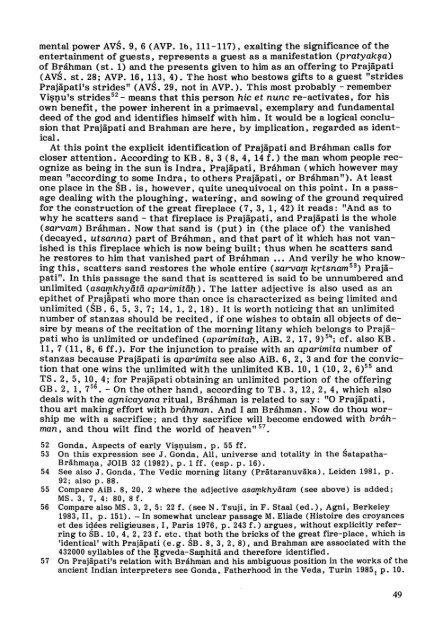Prajapati's relations with Brahman, Brhaspati and Brahma - DWC
Prajapati's relations with Brahman, Brhaspati and Brahma - DWC
Prajapati's relations with Brahman, Brhaspati and Brahma - DWC
You also want an ePaper? Increase the reach of your titles
YUMPU automatically turns print PDFs into web optimized ePapers that Google loves.
ment al power AVS. 9, 6 (AVP. 1b, 111-117), exalting the significance of the<br />
entertainment of guests, represents a guest as a manifestation (pratyak~a)<br />
of Bráhman (st. 1) <strong>and</strong> the presents given to him as an offering to Prajäpati<br />
(AVS. st. 28; AVP. 16,113,4). The host who bestows güts to a guest "strides<br />
Prajäpati's strides" (AVS. 29, not in AVP.). This most probably - remember<br />
Vi!?t:lu's strides 52 - means that this person hic et nunc re-activates, for his<br />
own benefit , the power inherent in a primaeval, exemplary <strong>and</strong> fundamental<br />
deed of the god <strong>and</strong> identifies himself <strong>with</strong> him. It would be a logical conclusion<br />
that Prajäpati <strong>and</strong> <strong><strong>Brahma</strong>n</strong> are here, by implication, regarded as identical.<br />
At this point the explicit identification of Prajäpati <strong>and</strong> Bráhman calls for<br />
closer attention . According to KB. 8, 3 (8, 4, 14 f. ) the man whom people recognize<br />
as being in the sun is Indra, Prajäpati, Bráhman (which however may<br />
mean "according to some Indra, to others Prajäpati, or Bráhman"). At least<br />
one place in the SB. is, however, q uite uneq uivocal on th is point. In a passage<br />
dealing <strong>with</strong> the ploughing, watering, <strong>and</strong> sowing of the ground required<br />
for the construction of the great fireplace (7,3, 1,42) it reads: "And as to<br />
why he scatters s<strong>and</strong> - that fireplace is Prajäpati, <strong>and</strong> Prajäpati is the whole<br />
(sarvam) Bráhman. Now that s<strong>and</strong> is (put) in (the place of) the vanished<br />
(decayed, utsanna) part of Bráhman, <strong>and</strong> that part of lt which has not vanished<br />
is this fireplace which is now being built; thus when he scatters s<strong>and</strong><br />
he restores to him that vanished part of Bráhman •.. And verily he who knowing<br />
this, scatters s<strong>and</strong> restores the whole entire (sarvap krtsnam53) Prajäpati".<br />
In this passage the s<strong>and</strong> that is scattered is said to be unnumbered <strong>and</strong><br />
unlimited (asapkhyiiUi aparimitä1;t). The lat ter adjective is also used as an<br />
epithet of Prajäpati who more than once is characterized as being limited <strong>and</strong><br />
unlimited (SB. 6, 5, 3, 7; 14, 1,2,18). It is worth noticing that an unlimited<br />
number of stanzas should be recited, if one wishes to obtain all objects of desire<br />
by means of the recitation of the morning litany which belongs to Prajäpat<br />
i who is unlimited or undefined (aparimita1;t, AiB. 2, 17, 9) 54; cf. also KB.<br />
11, 7 (11, 8, 6 ff.). For the injunction to praise <strong>with</strong> an aparimita number of<br />
stanzas because Prajäpati is aparimita see also AiB. 6, 2, 3 <strong>and</strong> for the conviction<br />
that one wins the unlimited <strong>with</strong> the unlimited KB. 10, 1 00, 2, 6)55 <strong>and</strong><br />
TS. 2, 5, 10, 4; for Prajäpati obtaining an unlimited portion of the offering<br />
GB. 2, 1, 7 56 • - On the other h<strong>and</strong>, according to TB. 3, 12, 2, 4, which also<br />
deals <strong>with</strong> the agnicayana ritual, Bráhman is related to say: "0 Prajäpati,<br />
thou art making effort <strong>with</strong> bráhman. And lam Bráhman. Now do thou worship<br />
me <strong>with</strong> a sacrifice; <strong>and</strong> thy sacrifice will become endowed <strong>with</strong> bráhman,<br />
<strong>and</strong> thou wilt find the world of heaven" 57.<br />
52 Gonda, Aspects of ear1y Vi!;u;lUism, p. 55 ff. ,<br />
53 On this expression see J. Gonda, All, universe <strong>and</strong> totality in the Satapatha<br />
BrähmaQa, JOIB 32 (1982), p. 1 ff. (esp. p. 16).<br />
54 See a1so J. Gonda, The Vedic morning litany (Prätaranuväka), Leiden 1981, p.<br />
92; a1so p. 88.<br />
55 Compare AiB. 8, 20, 2 where the adjective aS01pkhyätam (see above) is added;<br />
MS. 3, 7, 4: 80,8 f.<br />
56 Compare a1so MS. 3, 2, 5: 22 f. (see N. Tsuji, in F. Staal (ed.), Agni, Berke1ey<br />
1983, I1, p. 151). - In somewhat unc1ear passage M. E1iade (Histoire des croyances<br />
et des igées religieuses, I, Paris 1976, p. 243 f. ) argues, <strong>with</strong>out explicitly referring<br />
to SB. 10, 4, 2, 23 f. etc. that both the bricks of the great fire-p1ace, which is<br />
'identica1' <strong>with</strong> Prajäpati (e.g. SB. 8, 3, 2, 8), <strong>and</strong> <strong><strong>Brahma</strong>n</strong> are associated <strong>with</strong> the<br />
432000 syllab1es of the I.tgveda-Sarphitä <strong>and</strong> therefore identified.<br />
57 On Prajäpati's re1ation <strong>with</strong> Bráhman <strong>and</strong> his ambiguous position in the works of the<br />
ancient Indian interpreters see Gonda, Fatherhood in the Veda, Turin 1985 r p. 10.<br />
49
















